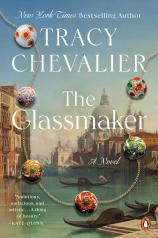The Glassmaker
Review
The Glassmaker
I’ve heard many mainstream novelists questioned in interviews about the most challenging aspects of the craft. Most of their answers, as one might expect, revolve around foundational issues, such as character, plot or place.
But as I delved into the fascinating Venetian world of THE GLASSMAKER, what struck me was Tracy Chevalier’s creative reshaping of an element most writers feel they must be accountable for in strict sequential detail --- time. To say the least, Chevalier bends that rule beautifully. By the end of the first chapter, she had drawn me into the colorful and competitive world of 15th-century Venetian glassmaking, specifically on the semi-reclusive island of Murano, where the majority of glass artisans lived then and for centuries later.
"Rather than defying the currents of history, THE GLASSMAKER treats time like the materials of glass itself, heating its raw information into condensed form and shaping it in the writer’s crucible into something that is simultaneously new, old, unexpected and beautiful."
I had become fascinated by Chevalier’s powerful but traditionally constrained leading character, who even in childhood desperately wants to be a glass maestro. Orsola Rosso spends her entire life pushing against the social and economic boundaries that an ancient patriarchy of glassmakers had erected around any and all women wanting to take part in the honored profession of turning sand into luminous treasures, both practical and luxurious.
Then Chevalier suddenly jumps ahead by nearly another century, while Orsola’s life --- and that of her extended and fractious family --- advances by only a few years. As a young woman, Orsola finds precious time and materials in between her expected (and unpaid) female duties of cooking, cleaning, child-rearing and caring for the sick, to learn the delicate and demanding skill of bead-making, mainly because the men of her age had little use for it. She earns money, almost unheard of for women of her time and for much longer. From that point on, her glorious Murano beads become a literal thread, like a centuries-long necklace connecting this amazing story.
Chevalier’s time jumps, elegantly described as skipping flat stones across the water toward Murano, become ever more dramatic and disruptive as the world of “terra firma” beyond the human-made Venetian islands changes with seemingly accelerated speed.
Upheavals from war, changing economic trends, plagues (from Bubonic to COVID-19), industrial technologies, fashions, languages, transportation (gondolas giving way to motor barges), customs, climate change (especially the devastating recent aqua alta events that frequently have flooded Venice itself) --- all seem to swirl around the outskirts of the time bubble that has become Orsola’s and Murano’s existence.
But not quite.
THE GLASSMAKER manipulates time not as a sleight-of-hand trick, but to impress on us that individual human lives not only reflect the larger world in microcosm, but also can influence it. No one is too small, poor or powerless to make a difference if they persist against all odds.
As I followed Orsola’s slow aging and mindful wisdom through some five-and-a-half centuries of achievement and setback, love and loss, stability and destruction, change became a truly artistic element of the story, not something to be endured, ignored or railed against. It is Orsola who prevails into the 2020s as the ancient art of glassmaking dwindles around her but is never quite extinguished.
Rather than defying the currents of history, THE GLASSMAKER treats time like the materials of glass itself, heating its raw information into condensed form and shaping it in the writer’s crucible into something that is simultaneously new, old, unexpected and beautiful.
Reviewed by Pauline Finch on August 9, 2024
The Glassmaker
- Publication Date: June 17, 2025
- Genres: Fiction, Historical Fiction, Women's Fiction
- Paperback: 416 pages
- Publisher: Penguin Books
- ISBN-10: 0525558292
- ISBN-13: 9780525558293




